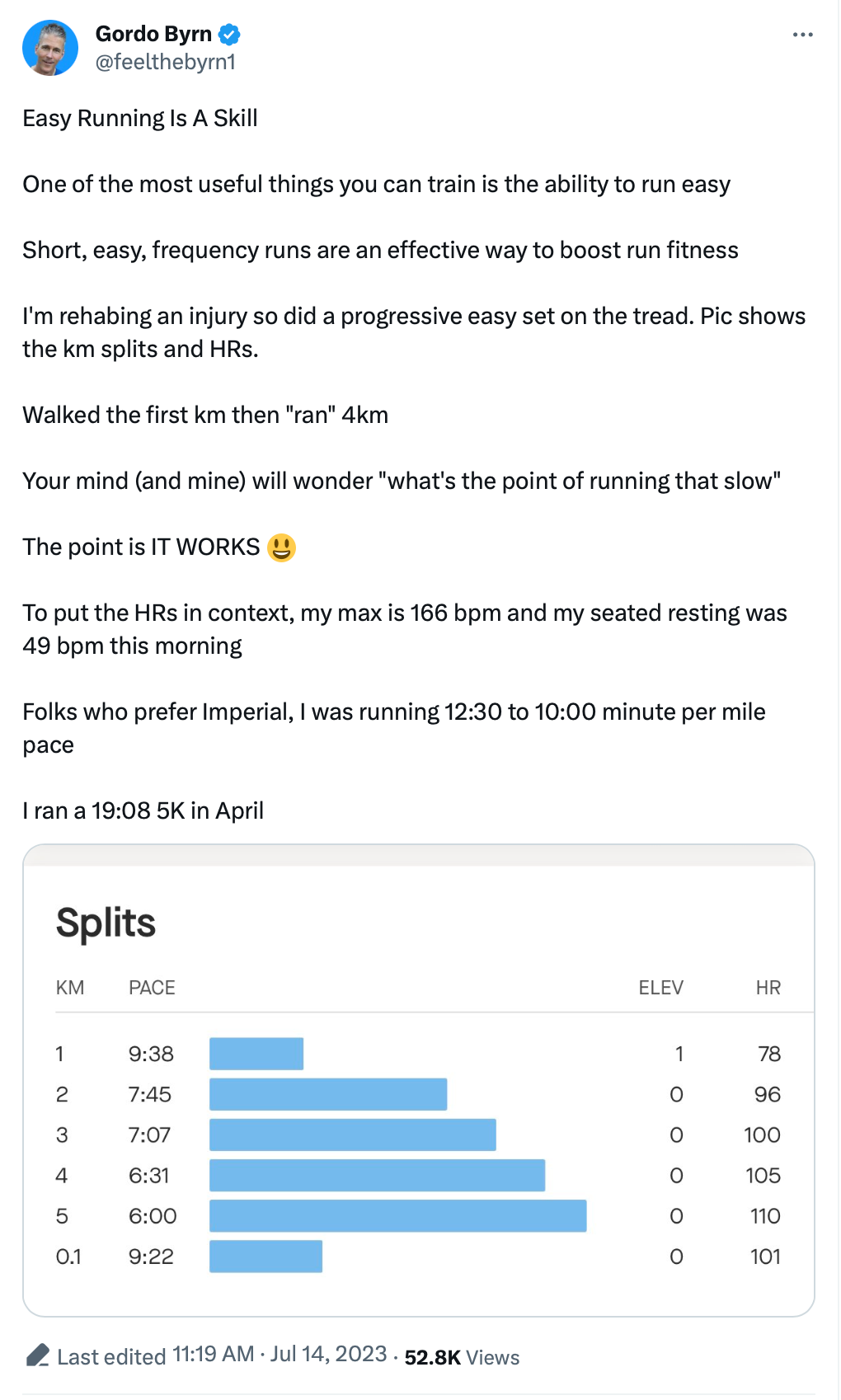A tweet on the skill of easy running started a conversation.
Discussion of “easy pace” is accompanied by common questions and reactions:
You won’t improve if you go easy all the time.
Isn’t it better to go more intensely?
What, specifically, improves with easy pace?
Digging into these questions is our topic for today. My goal is to explain what you get by building a portfolio of easy.
How Much Easy
My experience training alongside amateur athletes is there are a lot more people going easy “none of the time” than “all of the time.”
Start by using the resources we’ve shared to understand your Easy & Steady Zones. The Setting Zones section gives you want you need.
Then test yourself.
How long can I hold Easy Pace in a session?
How much can I do in a day?
How much can I do in a microcycle (4-10 days)?
Once zones are set correctly, pay attention to them. It’s easy to fall into a pattern of revving-the-engine, most every day.
All these spikes, Red Zone efforts and blocks of Tempo… reduce an athlete’s ability to do work.
Particularly for…
Athletes seeking to make the transition from Recreational to Competitive.1
Athletes who have a race duration longer than their typical long day.
I challenge you to:
Get your Easy/Steady zones set correctly.
Stop spiking on your endurance days.
Highly motivated athletes2 (and the chronically overreached)3 have a baseline where anything that’s not exhausting is easy.
Relax.
Your endurance days are meant to be enjoyable, sustainable and repeatable.
Types of Easy
Easy has multiple dimensions. Most often, it is our metabolic and mechanical limiters that interrupt fitness compounding.
Consider
Aerobic, defined by heart rate
Metabolic, defined by lactate
Mechanical, defined by what it takes to break us down
Mechanical - If you're new to running then "mechanical" is the one that's going to bite you in the butt (or calf, or hamstring, or TFL, or ITB...)
Your job is to keep yourself in the game, at any speed.
I was reminded of this recently when my “mostly easy” (aerobic/metabolic) program came to a halt due to not paying enough attention to my mechanical limiters.
Metabolic / Internal - If you're getting unusually fatigued by your "easy aerobic" then test metabolics with lactate.4
Top-down charts can't see what's happening inside our bodies. It might be an "easy" velocity based on a pace chart but quite challenging internally.
Stay In The Game
Nobody, especially John and me, is saying you can’t rev your engine.
What we are encouraging you to do is…
Perform a limited number of intense sessions with intent
and remember the intention is to…
Get faster on race day.
With performance in mind, and having seen hundreds of athletes over do it, we recommend you start bottom-up with your endurance training.
Why?
Because it is unlikely that you are going too easy.
Consistent work over time is the critical success factor
To build a habit of consistent work, aim low & do it daily
Make adjustments by:
More frequency - increase your average weekly frequency
More duration - extend your longest endurance day(s)
More strength - additional specific preparation sessions5
It’s OK to perform your endurance training at an intensity level you enjoy and can sustain.
Enjoying work over time is what will move you up the performance curve. This work will transform your physiology, creating the general capacity to absorb your specific sessions.
A Portfolio of Easy
Create a portfolio of easy.6
Consider your favorite modes of endurance training (swim, bike, run, hike, climb, ski…).
Build the ability to perform these modes in variable terrain (flats, hills & rollers) whenever you want.
Give yourself the ability to choose your intensity regardless of the sport, and terrain.
Creating this portfolio will give additional purpose to your Green Zone training.
Sure, you are trying to get to the finish line faster on race day.
But what you are also doing is expanding your world, quite literally. Our low end stamina enables us to undertake epic journeys and expand our horizons.
Exploring the world is a lot of fun. Fun creates a positive feedback loop that keeps us coming back to our program.
The Performance Payoff
A stamina focus is not simply about having fun and doing epic sessions. It addresses a fundamental reality.
An individual can only absorb a finite amount of Tempo/Red Zone work.
This amount is lower than most of us expect, and target.
Green Zone volume, particularly at the easier end, expands an athlete’s general capacity to absorb specific stress.
This general capacity gives an athlete metabolic flexibility:
The ability to recover while moving.
The ability to absorb more frequent sessions.
The ability to perform more total work.
The ability to fuel, and recover from, more intense work.
“Easy training” is not the program or a protocol.
It is an important piece of an overall program.
Back to Table of Contents
For more on the Transition from Recreational to Competitive see our Basic Week series.
You might not think of yourself as a Highly Motivated Athlete. You are. Any person who consistently reads articles about endurance training has a part of their psyche that is VERY passionate about sport. Scratch that itch. Don’t wait to be great.
See our section on The Tired Athlete.
My YouTube Channel has extensive resources for applied lactate testing.
Even short triathlons are long endurance events. The most useful forms of intensity are: hills; specific work done one “gear” up from average race intensity; and sessions that target athlete durability.
Walking, hiking and biking are where most of us will need to start. More info in my article, Cycling As The Foundation For Metabolic Fitness.





